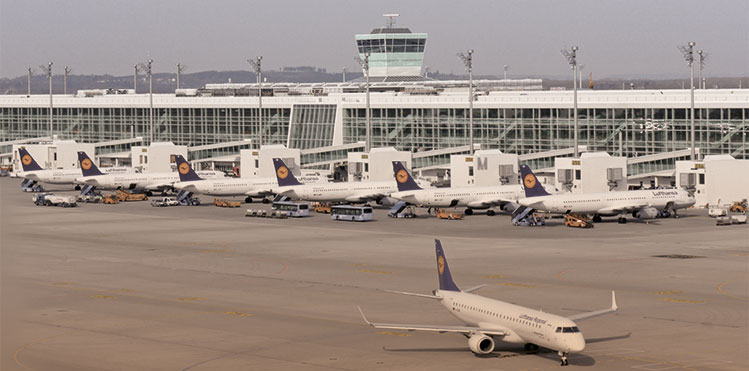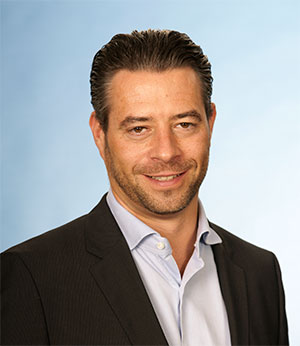
As this edition of Airport Business went to press, final preparations were underway for the opening of Munich Airport’s T2 satellite building. Philipp Ahrens, Director Project Team Satellite, Terminal 2 Management Company, Munich Airport, updated Ross Falconer on the project ahead of the official opening ceremony on 22 April and the start of operations four days later.
A passion for the passenger experience is ingrained in Munich Airport’s philosophy. While self-service bag drop and fast-track security lanes are among the elements that streamline the airport journey, some of the more creative initiatives include InfoGates that allow travellers to interact with offsite agents, and a free-to-access Recreation Area.
Indeed, this passenger focus has been front and centre in the development of the new T2 satellite building, which Philipp Ahrens, Director Project Team Satellite, Terminal 2 Management Company, Munich Airport, explains is “designed to provide a real improvement in passenger comfort and quality of service.”
Before going into detail about the new T2 satellite, it is worth at this point noting the context in which Munich Airport is being expanded. Bavaria’s international hub is firmly on a growth trajectory. It handled 41 million passengers in 2015 (+3%) – the first time it had exceeded 40 million – and the upward trend is forecast to continue. 15,000 additional aircraft movements are expected this year – a rise of 4%. It is against this background of rising traffic that the airport is opening its new T2 satellite building. The official opening ceremony takes place on 22 April, with operations beginning four days later. The €900 million investment includes the satellite terminal, extension of the apron layout and modification of the baggage sorting system.
A passion for the passenger experience is ingrained in Munich Airport’s philosophy. While self-service bag drop and fast-track security lanes are among the elements that streamline the airport journey, some of the more creative initiatives include InfoGates that allow travellers to interact with offsite agents, and a free-to-access Recreation Area.
Indeed, this passenger focus has been front and centre in the development of the new T2 satellite building, which Philipp Ahrens, Director Project Team Satellite, Terminal 2 Management Company, Munich Airport, explains is “designed to provide a real improvement in passenger comfort and quality of service.”
Before going into detail about the new T2 satellite, it is worth at this point noting the context in which Munich Airport is being expanded. Bavaria’s international hub is firmly on a growth trajectory. It handled 41 million passengers in 2015 (+3%) – the first time it had exceeded 40 million – and the upward trend is forecast to continue. 15,000 additional aircraft movements are expected this year – a rise of 4%. It is against this background of rising traffic that the airport is opening its new T2 satellite building. The official opening ceremony takes place on 22 April, with operations beginning four days later. The €900 million investment includes the satellite terminal, extension of the apron layout and modification of the baggage sorting system.
“The vision started in the late-90s when Munich Airport and Lufthansa signed an MoU to create a joint venture – The Terminal 2 Management Company (with a 60/40 split) – when they started financing, planning and constructing Terminal 2 as a dedicated Lufthansa/Star Alliance terminal,” Ahrens says. “This success story, which is still unique in Europe, proved to be a good decision, as Terminal 2’s nominal capacity of 25 million passengers has been exceeded four years in a row now, and clearly indicates the urgent need for additional capacity on the ground.”
Construction of the new satellite began in April 2012 to the east of Terminal 2. It adds capacity for a further 11 million passengers to the Terminal 2 system, as well as 27 contact stands, increasing the total to 51, for Lufthansa and its Star Alliance partners.
“Continuously improving services for passengers”
As the satellite is a midfield building, it is separated by three parallel taxiways from Terminal 2. The tunnels under the apron, which connect the satellite with Terminal 2, are used for the passenger transport system as well as baggage transport between the two buildings. The baggage sorting system in the east of Terminal 2 was constructed in a way that it could be the future baseline for the satellite building. Siemens has modernised and extended the baggage handling system, with sorting capacity increased by one-third to 17,800 bags per hour.

Philipp Ahrens, Director Project Team Satellite, Terminal 2 Management Company, Munich Airport: “Our aim is to continuously improve our services for the airlines and for passengers. The new satellite will definitely maximise convenience for guests.”
“Another important goal was the increase in quality for passengers, when boarding or disembarking, by creating 27 additional contact stands,” Ahrens comments. “The building has been planned and constructed to be fully flexible, serving all types of traffic – Schengen, non-Schengen and non-EU arrival traffic – on three different levels, following the same philosophy as in Terminal 2.
Since the Terminal 2 system is exclusively reserved for Lufthansa and its Star Alliance partners, the satellite building aims at seamless transfer processes.”
The passenger experience is also being enhanced with free ‘work & relax’ zones, family areas, charging areas for mobile devices, and free WiFi connectivity. Meanwhile, the commercial concept will be augmented with digital media walls. The new market place area surrounding the apron tower will be the commercial heart of the building, reflecting the city of Munich and Bavarian culture.
“Our aim is to continuously improve services for the airlines and for passengers,” Ahrens says. “The new satellite will definitely maximise convenience for guests because the 27 new contact stands will offer easy access from the gates. Passengers who start their journey from the satellite, therefore, do not need a bus transfer to reach their planes. That means they have even more time to spend in this fascinating building and can enjoy the large variety of attractive shops and restaurants.”
Green Satellite: Maximising energy efficiency
Munich Airport is also committed to environmental innovation and is currently at Level 3 Optimisation of ACI’s Airport Carbon Accreditation. Innovative heating, cooling and lighting technologies are being utilised to minimise energy usage in the new satellite. Modern scavenging air ventilation technology optimises climate control, and the so-called double climate façade will work as a climate buffer between the outer shell of the building and the inner part. Meanwhile, the lighting incorporates LEDs and dimming technology, and Ahrens explains that these initiatives will result in CO2 emissions in the satellite being 40% lower than in the two existing terminals.
The next extension is already planned – a “T-Stick” towards the east for an additional six million passengers.
Looking further ahead, the next big step for the airport will be the extension of Terminal 1 towards the apron. The project is still in the early planning stages, but we do know that it will create more space for gates, waiting areas, shops and restaurants.







